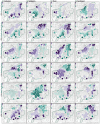Relationships between community public service facilities and social capital: An exploratory study of Harbin, China
- PMID: 40019917
- PMCID: PMC11870347
- DOI: 10.1371/journal.pone.0318144
Relationships between community public service facilities and social capital: An exploratory study of Harbin, China
Abstract
Social capital is closely intertwined with neighborhood environments and facility provisions. It is a vital resource for supporting residents' happiness and satisfaction. In the context of urban stock development and the concentrated construction of community public service facilities, it remains unclear whether the spontaneous construction of facilities follows a colocation model and how facility-related construction affects residents' quality of life. In this study, we used a questionnaire survey to analyze social capital, summarizing it into aspects such as community cohesion, social support, community trust, and sense of belonging. Then, we acquired the points of interest for facilities in Harbin, China, computed the Global Colocation Quotient (GCLQ) and Local Colocation Quotient (LCLQ), the proportion of spatial units occupied by facilities, and the Shannon diversity index, and analyzed the patterns. Aged care services, childcare centers, and community cultural services were found to have the strongest mutual attractions. Finally, an ordinary least squares model was constructed. The proportion of spatial units occupied by community public service facilities was closely related to social capital growth. In the relationship between the colocation model and social capital, LCLQ-healthcare showed a negative correlation, LCLQ-aged care and LCLQ-childcare showed a positive correlation, and LCLQ-cultural and sports showed a positive correlation with a sense of community belonging. The geographically weighted regression model indicated significant spatial heterogeneity in how facility-related construction affects social capital. This study offers a foundation and reference for the sustainable planning and development of integrated community public service facilities.
Copyright: © 2025 Luo et al. This is an open access article distributed under the terms of the Creative Commons Attribution License, which permits unrestricted use, distribution, and reproduction in any medium, provided the original author and source are credited.
Conflict of interest statement
The authors have declared that no competing interests exist.
Figures








Similar articles
-
The Effects of Urban Neighborhood Environmental Evaluation and Health Service Facilities on Residents' Self-Rated Physical and Mental Health: A Comparative and Empirical Survey.Int J Environ Res Public Health. 2022 Apr 8;19(8):4501. doi: 10.3390/ijerph19084501. Int J Environ Res Public Health. 2022. PMID: 35457365 Free PMC article.
-
Relationship between social capital and happiness in a Japanese community: A cross-sectional study.Nurs Health Sci. 2019 Jun;21(2):245-252. doi: 10.1111/nhs.12589. Epub 2018 Dec 28. Nurs Health Sci. 2019. PMID: 30592119
-
The role of neighborhood social capital on health and health inequality in rural and urban China.Prev Med. 2022 Mar;156:106989. doi: 10.1016/j.ypmed.2022.106989. Epub 2022 Feb 9. Prev Med. 2022. PMID: 35150751
-
Social capital, neighbourhood characteristics and utilisation of local public health services among domestic migrants in China: a cross-sectional study.BMJ Open. 2017 Aug 18;7(8):e014224. doi: 10.1136/bmjopen-2016-014224. BMJ Open. 2017. PMID: 28821507 Free PMC article.
-
Can social capital play a role in contracting services of family doctors in China? Reflections based on an integrative review.BMC Fam Pract. 2021 Jun 21;22(1):117. doi: 10.1186/s12875-021-01431-x. BMC Fam Pract. 2021. PMID: 34148556 Free PMC article. Review.
References
-
- Putnam RD, Leonardi R, Nonetti RY. Making democracy work: Civic traditions in modern Italy. New Jersey: Princeton University Press; 1993. doi: 10.2307/j.ctt7s8r7 - DOI
-
- Dempsey N. Does quality of the built environment affect social cohesion?. Proc Inst Civ Eng Urban Des Plan. 2008;161(3):105–14. doi: 10.1680/udap.2008.161.3.105 - DOI
-
- Hyonkun K. A study on influential factors on neighborhood-related social capital. Korean Soc & Pub Admin. 2003;14:259–85.
-
- Garde A. New urbanism: past, present, and future. Urban Plan. 2020;5(4):453–63. doi: 10.17645/up.v5i4.3478 - DOI
-
- Yu W, Ai T, Yang M, Liu J. Detecting “hot spots” of facility POIs based on kernel density estimation and spatial autocorrelation technique. Geom Inf Sci Wuhan Univ; 2016. doi: 10.13203/j.whugis20140092 - DOI
MeSH terms
LinkOut - more resources
Full Text Sources

